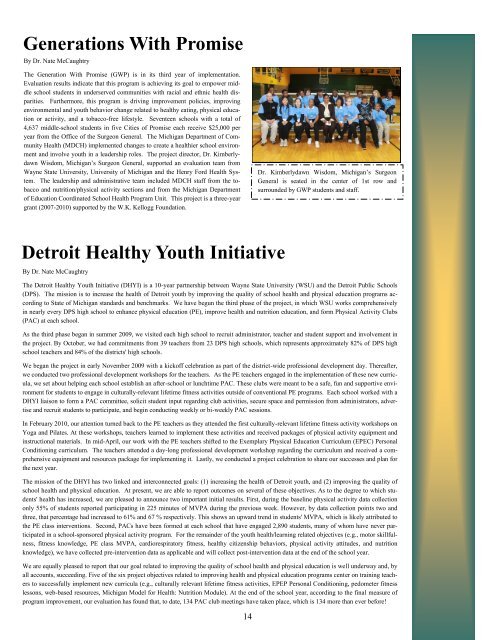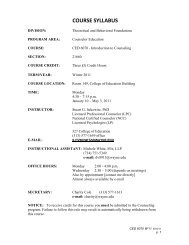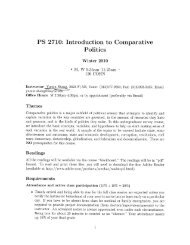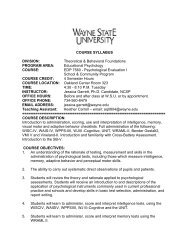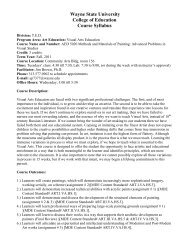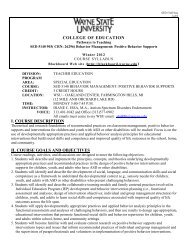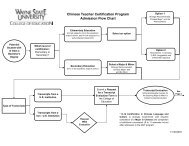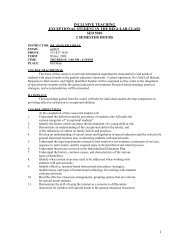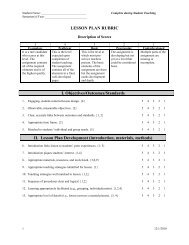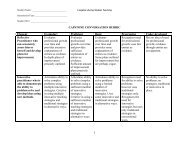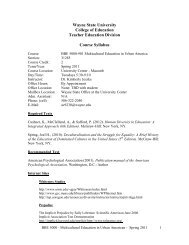Division of KHS - College of Education - Wayne State University
Division of KHS - College of Education - Wayne State University
Division of KHS - College of Education - Wayne State University
Create successful ePaper yourself
Turn your PDF publications into a flip-book with our unique Google optimized e-Paper software.
Generations With Promise<br />
By Dr. Nate McCaughtry<br />
The Generation With Promise (GWP) is in its third year <strong>of</strong> implementation.<br />
Evaluation results indicate that this program is achieving its goal to empower middle<br />
school students in underserved communities with racial and ethnic health disparities.<br />
Furthermore, this program is driving improvement policies, improving<br />
environmental and youth behavior change related to healthy eating, physical education<br />
or activity, and a tobacco-free lifestyle. Seventeen schools with a total <strong>of</strong><br />
4,637 middle-school students in five Cities <strong>of</strong> Promise each receive $25,000 per<br />
year from the Office <strong>of</strong> the Surgeon General. The Michigan Department <strong>of</strong> Community<br />
Health (MDCH) implemented changes to create a healthier school environment<br />
and involve youth in a leadership roles. The project director, Dr. Kimberlydawn<br />
Wisdom, Michigan’s Surgeon General, supported an evaluation team from<br />
<strong>Wayne</strong> <strong>State</strong> <strong>University</strong>, <strong>University</strong> <strong>of</strong> Michigan and the Henry Ford Health System.<br />
The leadership and administrative team included MDCH staff from the tobacco<br />
and nutrition/physical activity sections and from the Michigan Department<br />
<strong>of</strong> <strong>Education</strong> Coordinated School Health Program Unit. This project is a three-year<br />
grant (2007-2010) supported by the W.K. Kellogg Foundation.<br />
Detroit Healthy Youth Initiative<br />
By Dr. Nate McCaughtry<br />
The Detroit Healthy Youth Initiative (DHYI) is a 10-year partnership between <strong>Wayne</strong> <strong>State</strong> <strong>University</strong> (WSU) and the Detroit Public Schools<br />
(DPS). The mission is to increase the health <strong>of</strong> Detroit youth by improving the quality <strong>of</strong> school health and physical education programs according<br />
to <strong>State</strong> <strong>of</strong> Michigan standards and benchmarks. We have begun the third phase <strong>of</strong> the project, in which WSU works comprehensively<br />
in nearly every DPS high school to enhance physical education (PE), improve health and nutrition education, and form Physical Activity Clubs<br />
(PAC) at each school.<br />
As the third phase began in summer 2009, we visited each high school to recruit administrator, teacher and student support and involvement in<br />
the project. By October, we had commitments from 39 teachers from 23 DPS high schools, which represents approximately 82% <strong>of</strong> DPS high<br />
school teachers and 84% <strong>of</strong> the districts' high schools.<br />
We began the project in early November 2009 with a kick<strong>of</strong>f celebration as part <strong>of</strong> the district-wide pr<strong>of</strong>essional development day. Thereafter,<br />
we conducted two pr<strong>of</strong>essional development workshops for the teachers. As the PE teachers engaged in the implementation <strong>of</strong> these new curricula,<br />
we set about helping each school establish an after-school or lunchtime PAC. These clubs were meant to be a safe, fun and supportive environment<br />
for students to engage in culturally-relevant lifetime fitness activities outside <strong>of</strong> conventional PE programs. Each school worked with a<br />
DHYI liaison to form a PAC committee, solicit student input regarding club activities, secure space and permission from administrators, advertise<br />
and recruit students to participate, and begin conducting weekly or bi-weekly PAC sessions.<br />
In February 2010, our attention turned back to the PE teachers as they attended the first culturally-relevant lifetime fitness activity workshops on<br />
Yoga and Pilates. At these workshops, teachers learned to implement these activities and received packages <strong>of</strong> physical activity equipment and<br />
instructional materials. In mid-April, our work with the PE teachers shifted to the Exemplary Physical <strong>Education</strong> Curriculum (EPEC) Personal<br />
Conditioning curriculum. The teachers attended a day-long pr<strong>of</strong>essional development workshop regarding the curriculum and received a comprehensive<br />
equipment and resources package for implementing it. Lastly, we conducted a project celebration to share our successes and plan for<br />
the next year.<br />
The mission <strong>of</strong> the DHYI has two linked and interconnected goals: (1) increasing the health <strong>of</strong> Detroit youth, and (2) improving the quality <strong>of</strong><br />
school health and physical education. At present, we are able to report outcomes on several <strong>of</strong> these objectives. As to the degree to which students'<br />
health has increased, we are pleased to announce two important initial results. First, during the baseline physical activity data collection<br />
only 55% <strong>of</strong> students reported participating in 225 minutes <strong>of</strong> MVPA during the previous week. However, by data collection points two and<br />
three, that percentage had increased to 61% and 67 % respectively. This shows an upward trend in students' MVPA, which is likely attributed to<br />
the PE class interventions. Second, PACs have been formed at each school that have engaged 2,890 students, many <strong>of</strong> whom have never participated<br />
in a school-sponsored physical activity program. For the remainder <strong>of</strong> the youth health/learning related objectives (e.g., motor skillfulness,<br />
fitness knowledge, PE class MVPA, cardiorespiratory fitness, healthy citizenship behaviors, physical activity attitudes, and nutrition<br />
knowledge), we have collected pre-intervention data as applicable and will collect post-intervention data at the end <strong>of</strong> the school year.<br />
We are equally pleased to report that our goal related to improving the quality <strong>of</strong> school health and physical education is well underway and, by<br />
all accounts, succeeding. Five <strong>of</strong> the six project objectives related to improving health and physical education programs center on training teachers<br />
to successfully implement new curricula (e.g., culturally relevant lifetime fitness activities, EPEP Personal Conditioning, pedometer fitness<br />
lessons, web-based resources, Michigan Model for Health: Nutrition Module). At the end <strong>of</strong> the school year, according to the final measure <strong>of</strong><br />
program improvement, our evaluation has found that, to date, 134 PAC club meetings have taken place, which is 134 more than ever before!<br />
14<br />
Dr. Kimberlydawn Wisdom, Michigan’s Surgeon<br />
General is seated in the center <strong>of</strong> 1st row and<br />
surrounded by GWP students and staff.


